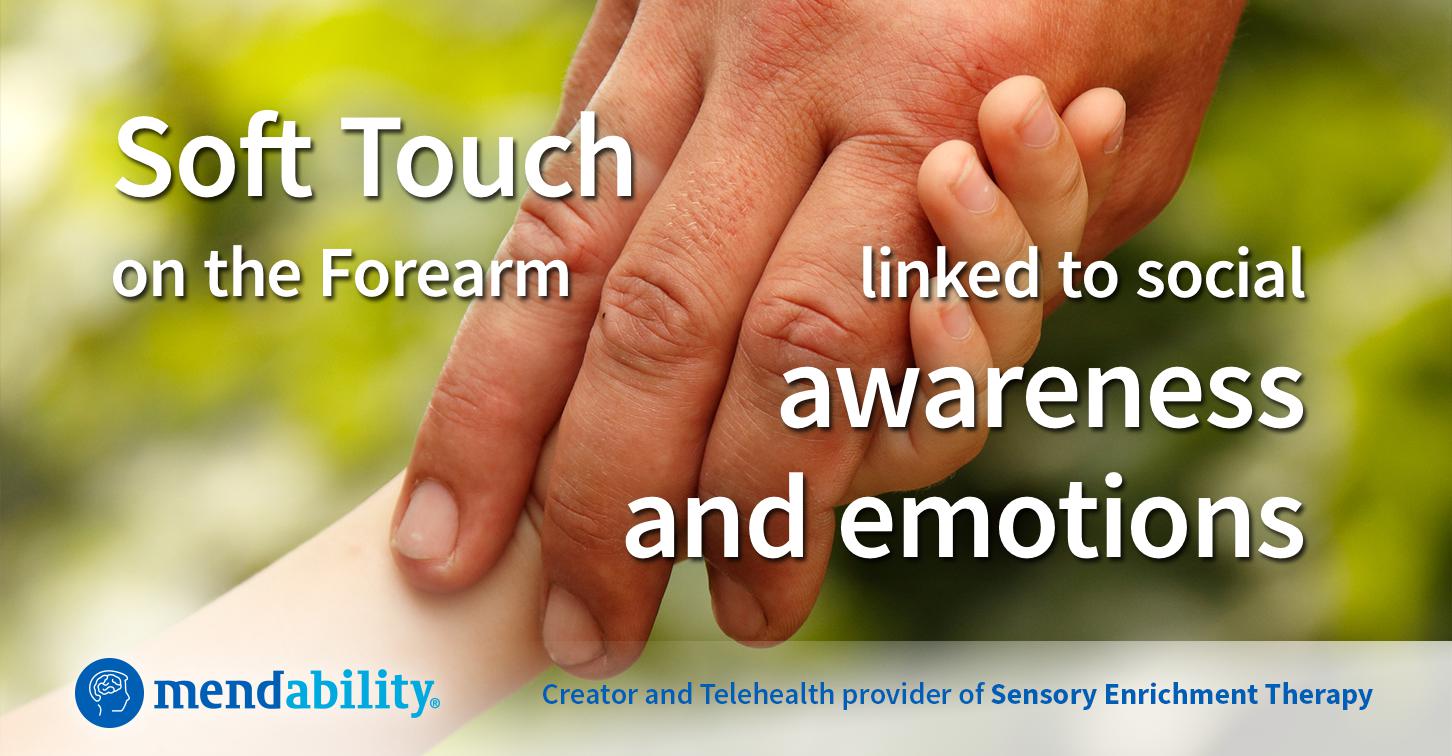The sense of touch is pivotal to learn and understand the environment. When a person touches an object, the sensory information regarding the texture and feel of that object is transferred to the brain. The area of the brain that processes this information differs based on which area of the body experienced the touch sensation. (Ackerley, Carlsson, Wester, Olausson, & Backlund Wasling, 2014)
Scientists recently discovered that soft touch sensations applied between the wrist and the elbow of a person’s forearm are processed by the prefrontal cortex (responsible for social awareness) and amygdala (responsible for emotion control), whereas sensory input to the palm of the hand is processed by the parietal lobe (responsible for the identification of texture and temperature). (Kaiser et al. 2015) Consequently, soft touch on the forearm evokes an individual’s awareness of others and promotes emotional control. Autism therapy should include protocols to rehabilitate the sense of touch in order to facilitate the development of social skills.
In autism, where social skills are usually underdeveloped, those soft touches on the forearm do not elicit activation in the same way as neurotypical individuals and they do not have a social significance. Additionally, most children with autism are hypersensitive to touch and become defensive to certain textures and pressures. Soft touch is rarely a pleasurable experience for the child with autism. Instead, individuals with autism often prefer and seek out deep pressure and tight squeezes. These preferences are the result of a deficit in the tactile processing system. (Güçlü, Tanidir, Mukaddes, & Unal, 2007)
It is important for children with autism to develop a functional level of tactile processing so that they can gain a greater understanding of social awareness and emotional control associated with soft touch.
Mendability, a unique, new autism therapy, provides a wide range of exercises involving tactile discovery and novel sensory experiences, which are specifically designed to restructure the way that the brain is organized.
With Sensory Enrichment Therapy, for a few minutes each day, the parent is invited to softly touch the child while offering a pleasant scent to smell. The soft touch involves using the tips of their fingers in random motions. Touch often starts with the palms of the hands and soles of the feet, then gradually progresses to the child’s arm, back, neck, or head. With regular exposure and experience, the child develops a real enjoyment of the process, a stronger connection with parents, and a feeling of relaxation. This protocol rapidly becomes one of the child’s favorite experiences. (Rangel & Leon, 1995)
[av_toggle_container av_uid=’av-2t2fkr’]
[av_toggle title=’References’ tags=” av_uid=’av-490ae3′]
- Ackerley, R., Carlsson, I., Wester, H., Olausson, H., & Backlund Wasling, H. (2014). Touch perceptions across skin sites: differences between sensitivity, direction discrimination and pleasantness. Frontiers in Behavioral Neuroscience, 8, 54.
- Güçlü, B., Tanidir, C., Mukaddes, N. M., & Unal, F. (2007). Tactile sensitivity of normal and autistic children. Somatosensory & Motor Research, 24(1-2), 21–33.
- Kaiser, M. D., Yang, D. Y.-J., Voos, A. C., Bennett, R. H., Gordon, I., Pretzsch, C., … Pelphrey, K. A. (2015). Brain Mechanisms for Processing Affective (and Nonaffective) Touch Are Atypical in Autism. Cerebral Cortex . http://doi.org/10.1093/cercor/bhv125
- Rangel, S., & Leon, M. (1995). Early odor preference training increases olfactory bulb norepinephrine. Brain Research. Developmental Brain Research, 85(2), 187–191.
[/av_toggle]
[/av_toggle_container]
[av_hr class=’default’ height=’50’ shadow=’no-shadow’ position=’center’ custom_border=’av-border-thin’ custom_width=’50px’ custom_border_color=” custom_margin_top=’30px’ custom_margin_bottom=’30px’ icon_select=’yes’ custom_icon_color=” icon=’ue808′ font=’entypo-fontello’ av_uid=’av-7y2g9′ custom_class=” admin_preview_bg=”]
[av_promobox button=’yes’ label=’Give it a try!’ link=’page,2339′ link_target=” color=’theme-color’ custom_bg=’#444444′ custom_font=’#ffffff’ size=’large’ label_display=” icon_select=’yes’ icon=’ue82b’ font=’entypo-fontello’ box_color=’custom’ box_custom_font=” box_custom_bg=’#def4fc’ box_custom_border=” av_uid=’av-jly8o0ce’ custom_class=” admin_preview_bg=”]
Are social awareness or emotions areas of concern for you or your loved one?
Sensory Enrichment Therapy™ helps develop social awareness and improved emotional responses by boosting brain development in these areas.
[/av_promobox]
[av_hr class=’invisible’ height=’-50′ shadow=’no-shadow’ position=’center’ custom_border=’av-border-thin’ custom_width=’50px’ custom_border_color=” custom_margin_top=’30px’ custom_margin_bottom=’30px’ icon_select=’yes’ custom_icon_color=” icon=’ue808′ font=’entypo-fontello’ av_uid=’av-jly8rlxm’ custom_class=” admin_preview_bg=”]
[av_textblock size=’14’ font_color=” color=” av-medium-font-size=” av-small-font-size=” av-mini-font-size=” av_uid=’av-jly8d2po’ custom_class=” admin_preview_bg=”]
Join 3,000 families in over 60 countries who have used Sensory Enrichment Therapy™ to help boost brain development in their own homes.
[/av_textblock]
[av_toggle_container initial=’0′ mode=’accordion’ sort=” styling=” colors=” font_color=” background_color=” border_color=” av_uid=’av-2njqsr’ custom_class=”]

